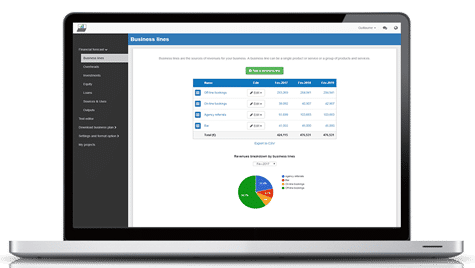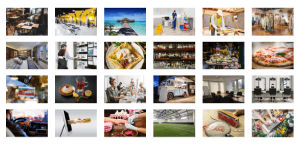How to create a financial forecast for a food truck?
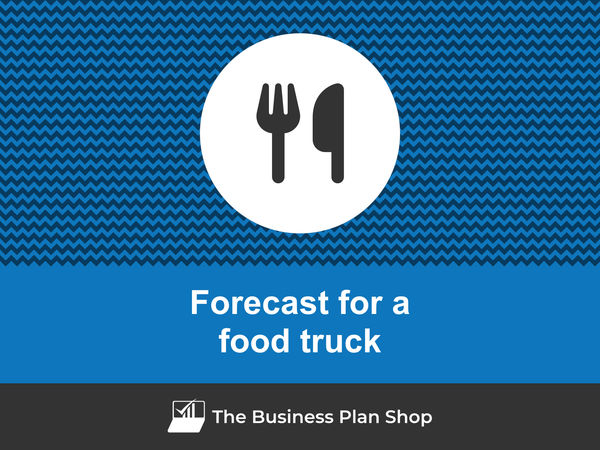
If you are serious about keeping visibility on your future cash flows, then you need to build and maintain a financial forecast for your food truck.
Putting together a food truck financial forecast may sound complex, but don’t worry, with the right tool, it’s easier than it looks, and The Business Plan Shop is here to guide you.
In this practical guide, we'll cover everything you need to know about building financial projections for your food truck.
We will start by looking at why they are key, what information is needed, what a forecast looks like once completed, and what solutions you can use to create yours.
Let's dive in!
Why create and maintain a financial forecast for a food truck?
Creating and maintaining an up-to-date financial forecast is the only way to steer the development of your food truck and ensure that it can be financially viable in the years to come.
A financial plan for a food truck enables you to look at your business in detail - from income to operating costs and investments - to evaluate its expected profitability and future cash flows.
This gives you the visibility needed to plan future investments and expansion with confidence.
And, when your trading environment gets tougher, having an up to date food truck forecast enables you to detect potential upcoming financing shortfalls in advance, enabling you to make adjustments or secure financing before you run out of cash.
It’s also important to remember that your food truck's financial forecast will be essential when looking for financing. You can be 100% certain that banks and investors will ask to see your numbers, so make sure they’re set out accurately and attractively.
Need a solid financial forecast?
The Business Plan Shop does the maths for you. Simply enter your revenues, costs and investments. Click save and our online tool builds a three-way forecast for you instantly.
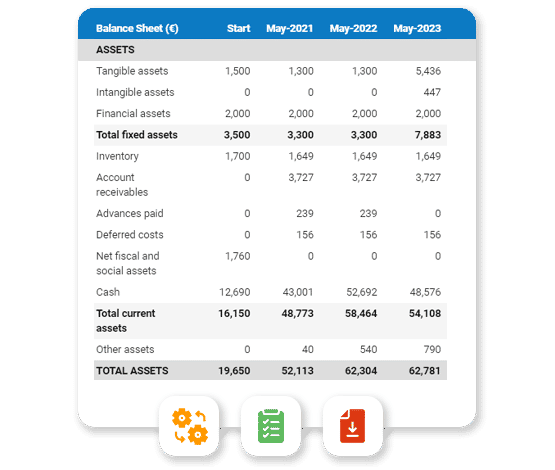
What information is used as input to build a food truck financial forecast?
A food truck's financial forecast is only as good as the inputs used to build it.
If you are creating (or updating) the forecast of an existing food truck, then you mostly need your accounting information, key historical operating non-financial data, and your team’s input on what to expect for the coming years.
If you are building financial projections for a food truck startup, you will need to have done your research and have a clear picture of your competitive environment and go-to-market strategy so that you can forecast sales accurately.
For a new venture, you will also need a precise list of the resources needed to keep the food truck running on a day-to-day basis and a list of the equipment and expenditures required to start the business (more on that later).
Let's now take a closer look at the elements that make up your food truck's financial forecast.
The sales forecast for a food truck
From experience, it is usually best to start creating your food truck financial forecast by your sales forecast.
To create an accurate sales forecast for your food truck, you will have to rely on the data collected in your market research, or if you're running an existing food truck, the historical data of the business, to estimate two key variables:
- The average price
- The number of monthly transactions
To get there, you will need to consider the following factors:
- Seasonal Demand: Depending on the location of your food truck, certain seasons may see higher demand for certain types of food. For example, if your food truck specializes in ice cream, you may see a decrease in monthly transactions during colder months.
- Competition: The presence of other food trucks or nearby restaurants offering similar types of food could affect your average price and number of monthly transactions. Keep an eye on your competitors and make adjustments to your menu and pricing accordingly.
- Location: The location of your food truck can greatly impact your sales. If you are situated in a busy area with high foot traffic, you may see more monthly transactions and be able to charge a higher average price. On the other hand, a less visible or accessible location may result in lower sales.
- Menu Changes: Introducing new items or changing your menu can affect your average price and number of monthly transactions. Consider conducting market research or surveying your customers before making any major menu changes to ensure they are well-received.
- Events: Participating in local events or festivals can greatly impact your sales forecast. Keep track of upcoming events in your area and consider setting up your food truck to take advantage of the increased foot traffic and potential for higher sales.
Once you have an idea of what your future sales will look like, it will be time to work on your overhead budget. Let’s see what this entails.
Need inspiration for your business plan?
The Business Plan Shop has dozens of business plan templates that you can use to get a clear idea of what a complete business plan looks like.
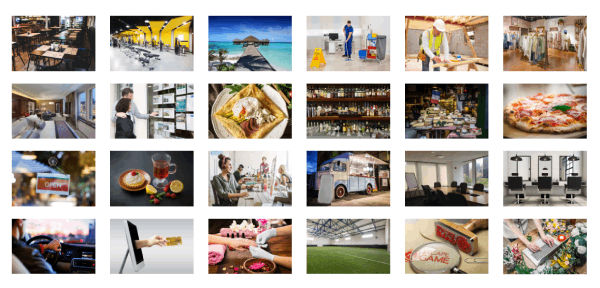
The operating expenses for a food truck
The next step is to estimate the expenses needed to run your food truck on a day-to-day basis.
These will vary based on the level of sales expected, and the location and size of your business.
But your food truck's operating expenses should include the following items at a minimum:
- Food Costs: This includes ingredients, supplies, and packaging for your menu items. You should monitor and adjust these costs regularly to ensure profitability.
- Labor Costs: This includes wages, benefits, and payroll taxes for your staff. You should track and manage these costs to ensure efficient staffing levels.
- Fuel Costs: Since your food truck is mobile, you will need to factor in the cost of fuel to operate your vehicle.
- Vehicle Maintenance: Regular maintenance and repairs for your food truck are necessary to keep it running smoothly and safely.
- Permits and Licenses: You will need to obtain various permits and licenses to legally operate your food truck, and these may have fees associated with them.
- Rent/Lease: If you are leasing a space to park your food truck, this will be an ongoing expense that you should factor into your budget.
- Utilities: This includes electricity, water, and gas for your food truck, as well as any fees for trash removal.
- Marketing and Advertising: Promoting your food truck and attracting customers will require some investment in marketing and advertising efforts.
- Accounting Fees: It's important to stay on top of your finances, so you may need to hire an accountant to help manage your books.
- Insurance: You will need to have insurance coverage for your food truck, including liability, auto, and possibly workers' compensation insurance.
- Software Licenses: If you are using any software to help manage your business, such as for inventory or scheduling, there may be ongoing fees for these licenses.
- Banking Fees: You may incur fees for transactions and services from your bank, such as ATM fees or wire transfer fees.
- Mobile Payment Fees: If you accept credit or debit card payments through a mobile payment service, there may be fees associated with each transaction.
- Repair and Maintenance: In addition to vehicle maintenance, you may need to budget for repairs and maintenance for equipment and appliances in your food truck.
- Taxes: As a business owner, you will be responsible for paying various taxes, including income, sales, and self-employment taxes.
This list is, of course, not exhaustive, and you'll have to adapt it according to your precise business model and size. A small food truck might not have the same level of expenditure as a larger one, for example.
What investments are needed to start or grow a food truck?
Your food truck financial forecast will also need to include the capital expenditures (aka investments in plain English) and initial working capital items required for the creation or development of your business.
For a food truck, these could include:
- Food Truck - This is the main fixed asset for your food truck business. It includes the cost of purchasing or leasing a truck, any necessary modifications or renovations, and equipment such as refrigerators, stoves, and sinks.
- Generator - A generator is essential for powering your food truck, especially if you plan on operating in locations without access to electricity. Make sure to budget for the cost of purchasing or renting a generator, as well as any maintenance or fuel costs.
- Point of Sale (POS) System - A POS system is necessary for processing customer payments and keeping track of sales and inventory. This can include equipment such as a cash register or tablet, as well as software and any necessary training.
- Kitchen Supplies - In addition to the equipment included in your food truck, you will also need to budget for any necessary kitchen supplies such as utensils, cookware, and cleaning supplies.
- Vehicle Insurance - Since your food truck is a mobile business, it is important to have insurance in case of any accidents or damages. Be sure to budget for the cost of insurance premiums for your food truck.
Again, this list will need to be adjusted according to the size and ambitions of your food truck.
Need a convincing business plan?
The Business Plan Shop makes it easy to create a financial forecast to assess the potential profitability of your projects, and write a business plan that’ll wow investors.
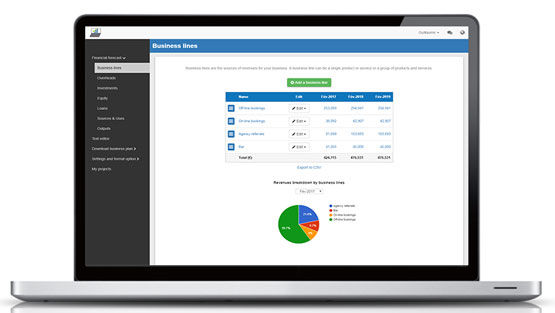
The financing plan of your food truck
The next step in the creation of your financial forecast for your food truck is to think about how you might finance your business.
You will have to assess how much capital will come from shareholders (equity) and how much can be secured through banks.
Bank loans will have to be modelled so that you can separate the interest expenses from the repayments of principal, and include all this data in your forecast.
Issuing share capital and obtaining a bank loan are two of the most common ways that entrepreneurs finance their businesses.
What tables compose the financial plan for a food truck?
Now let's have a look at the main output tables of your food truck's financial forecast.
The projected profit & loss statement
The projected profit & loss shows how profitable your food truck is likely to be in the years to come.
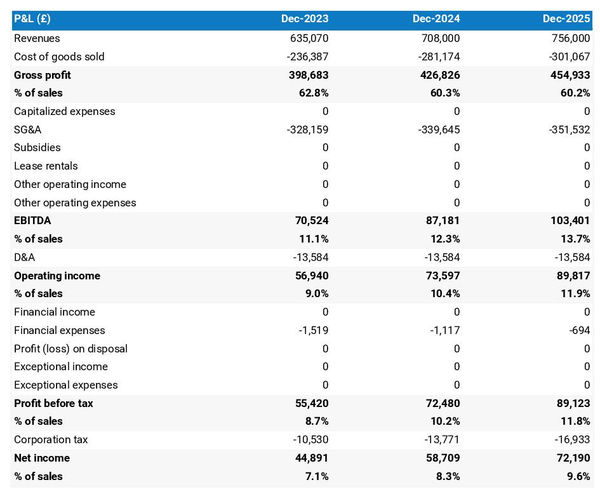
For your food truck to be financially viable, your projected P&L should ideally show:
- Sales growing above inflation (the higher the better)
- Profit margins which are stable or expanding (the higher the better)
- A net profit at the end of each financial year (the higher the better)
This is for established food trucks, there is some leniency for startups which will have numbers that will look a bit different than existing businesses.
The projected balance sheet
Your food truck's projected balance sheet provides a snapshot of your business’s financial position at year-end.
It is composed of three types of elements: assets, liabilities and equity:
- Assets: represent what the business possesses including cash, equipment, and accounts receivable (money owed by clients).
- Liabilities: represent funds advanced to the business by lenders and other creditors. They include accounts payable (money owed to suppliers), taxes payable and loans from banks and financial institutions.
- Equity: is the combination of what has been invested by the business owners and the cumulative profits and losses generated by the business to date (which are called retained earnings). Equity is a proxy for the value of the owner's stake in the business.
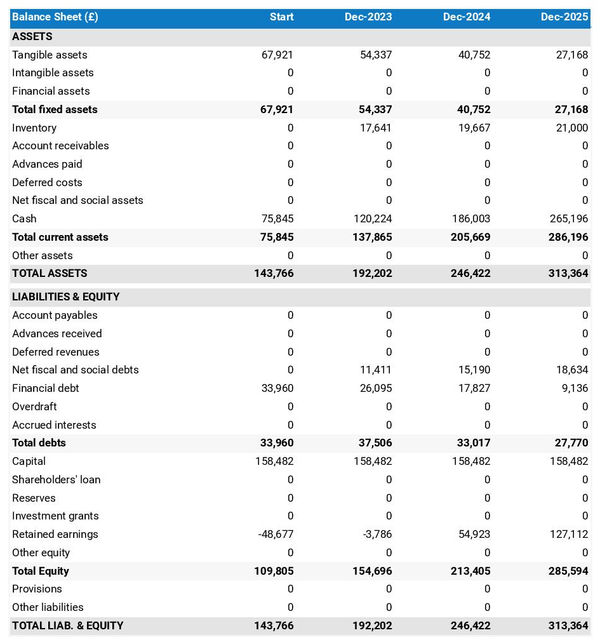
The cash flow forecast
Your food truck's cash flow forecast shows how much cash your business is expected to consume or generate in the years to come.
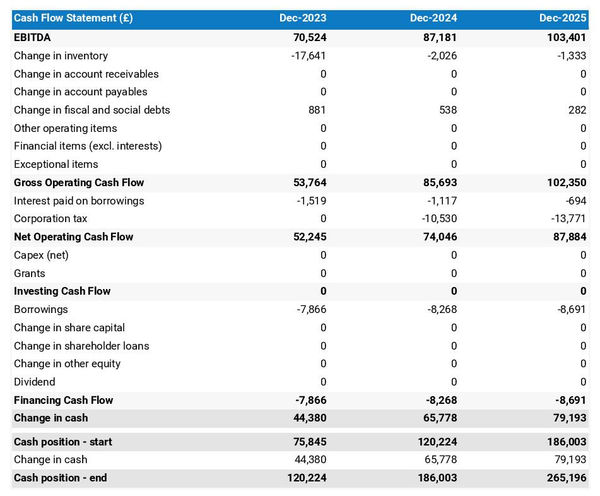
It is best practice to organise the cash flow forecast by nature to better explain where cash is used or generated by the food truck:
- Operating cash flow: shows how much cash is generated by the operating activities
- Investing cash flow: shows how much will be invested in capital expenditure to maintain or expand the business
- Financing cash flow: shows if the business is raising new capital or repaying financiers (debt repayment, dividends)
Keeping an eye on (and regularly updating) your food truck's cash flow forecast is key to ensuring that your business has sufficient liquidity to operate normally and to detect financing requirements as early as possible.
If you are trying to raise capital, you will normally be asked to provide a monthly cash flow forecast in your food truck's financial plan - so that banks or investors can assess seasonal variation and ensure your business is appropriately capitalised.
Need a solid financial forecast?
The Business Plan Shop does the maths for you. Simply enter your revenues, costs and investments. Click save and our online tool builds a three-way forecast for you instantly.

Which tool should you use to create your food truck's financial forecast?
Using the right tool or solution will make the creation of your food truck's financial forecast much easier than it sounds. Let’s explore the main options.
Using online financial projection software to build your food truck's forecast
The modern and easiest way to build a forecast is to use professional financial projection software such as the one we offer at The Business Plan Shop.
There are several advantages to using specialised software:
- You can easily create your financial forecast by letting the software take care of the financial calculations for you without errors
- You have access to complete financial forecast templates
- You get a complete financial forecast ready to be sent to your bank or investors
- You can easily track your actual financial performance against your financial forecast, and recalibrate your forecast as the year goes by
- You can create scenarios to stress test your forecast's main assumptions
- You can easily update your forecast as time goes by to maintain visibility on future cash flows
- You have a friendly support team on standby to assist you when you are stuck
- It’s cost-efficient and much cheaper than using an accountant or consultant (see below)
If you are interested in this type of solution, you can try our forecasting software for free by signing up here.
Hiring a financial consultant or chartered accountant
Hiring a consultant or chartered accountant is also an efficient way to get a professional food truck financial projection.
As you can imagine, this solution is much more expensive than using software. From experience, the creation of a simple financial forecast over three years (including a balance sheet, income statement, and cash flow statement) is likely to start around £700 or $1,000 excluding taxes.
The indicative estimate above, is for a small business, and a forecast done as a one-off. Using a financial consultant or accountant to track your actuals vs. forecast and to keep your financial forecast up to date on a monthly or quarterly basis will naturally cost a lot more.
If you choose this solution, make sure your service provider has first-hand experience in your industry, so that they may challenge your assumptions and offer insights (as opposed to just taking your figures at face value to create the forecast’s financial statements).
Why not use a spreadsheet such as Excel or Google Sheets to build your food truck's financial forecast?
You and your financial partners need numbers you can trust. Unless you have studied finance or accounting, creating a trustworthy and error-free food truck financial forecast on a spreadsheet is likely to prove challenging.
Financial modelling is very technical by nature and requires a solid grasp of accounting principles to be done without errors. This means that using spreadsheet software like Excel or Google Sheets to create accurate financial forecasts is out of reach for most business owners.
Creating forecasts in Excel is also inefficient nowadays:
- Software has advanced to the point where forecasting can be done much faster and more accurately than manually on a spreadsheet.
- With artificial intelligence, the software is capable of detecting mistakes and helping decision-making.
Spreadsheets are versatile tools but they are not tailor-made for reporting. Importing your food truck's accounting data in Excel to track actual vs. forecast is incredibly manual and tedious (and so is keeping forecasts up to date). It is much faster to use dedicated financial planning tools like The Business Plan Shop which are built specially for this.
Need a convincing business plan?
The Business Plan Shop makes it easy to create a financial forecast to assess the potential profitability of your projects, and write a business plan that’ll wow investors.

Use our financial projection templates for inspiration
The Business Plan Shop has dozens of financial forecast templates available.
Our examples contain a complete business plan with a financial forecast and a written presentation of the company, the team, the strategy, and the medium-term objectives.
Whether you are just starting out or already have your own food truck, looking at our financial forecast template is a good way to:
- Understand what a complete business plan should look like
- Understand how you should model financial items for your food truck
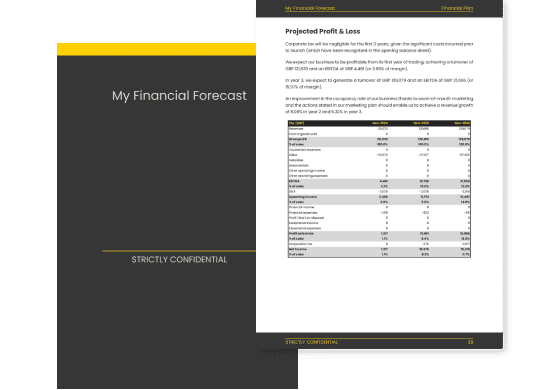
Takeaways
- Having a financial forecast enables you to visualise the expected growth, profitability, and cash generation for your business over the next three to five years.
- Tracking actuals vs. forecast and keeping your financial projections up-to-date is the only way to get a view on what your food truck future cash flows may look like.
- Using financial forecasting software is the mordern and easy way to create and maintain your forecasts.
This is the end of our guide on how to build the financial forecast for a food truck, we hope you found it useful. Don't hesitate to contact us if you want to share your feedback or have any questions.
Need inspiration for your business plan?
The Business Plan Shop has dozens of business plan templates that you can use to get a clear idea of what a complete business plan looks like.

Also on The Business Plan Shop
Know someone who owns or is thinking of starting a food truck? Share our forecasting guide with them!

